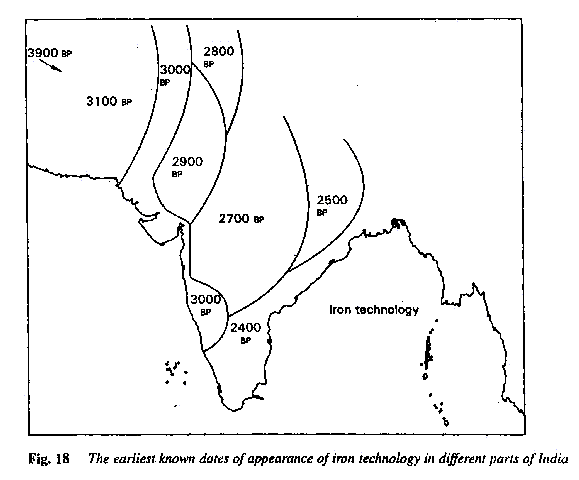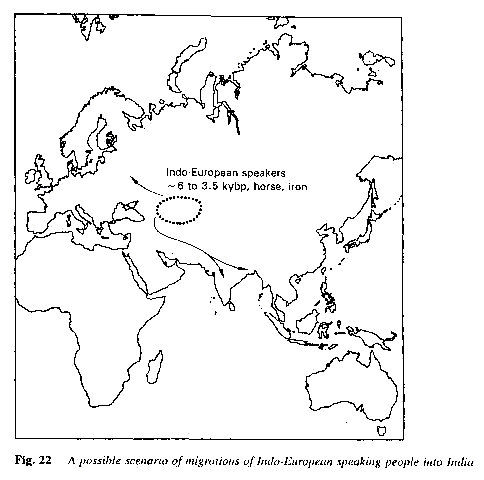
Go to Home page
Go Back to Origin of Bhandaries Page
Ancestors of Bhandaris
Introduction
There was migration of Aryan Nomadic Tribes from 1500 BC to 600 BC in India from Central Asia.
In figure 17, we can see domestication of horse in South Konkan and South Coastal Karnataka in approximately 3400-3000 ybp (years before present) must be first wave of Aryans in India. As per Archeological investigation of horse findings in Malvan (in Konkan), Shikarpur (in Kutch), Kuntasi (in Saurashtra) from Mature Harappan levels. This was a period when Rig-Veda was composed. So Brahmin associated with them are called Rig Vedic Brahmin. The peoples in this migration were not knowing farming hence they may have adapted Toddy Tapping profession as they have been migrated from cold region such as Himalaya mountains where drinking wine is must for survival.
In figure 17, we can see domestication of horse in South Konkan and Andra Pradesh in approximately 2900 - 2700 ybp must be second wave of Aryans in India. This was a period when Yajurveda was composed. So Brahmin associated with them are called Yajurvedi Brahmin. It is to be noted that Konkani and Andra Language are more close to each other. The some peoples in second migration must be knowing farming and hence that helps in farming practice in South Konkan. It is to be noted that Bhandaris ancestors previously both were engaged in hunting practice so the are more in eating non vegetarian food, evening they are farming or Toddy Tapping. After second migration farming must have rapidly spread and may due to some geographical reason it must not have reached all places of Konkan. It is to be noted that Kitte or Hetkari peoples are not different from each other, they difference by profession of Toddy Tapping or Farming.
Tree mostly used for settlement and education so they are prayed in various part of India.

Courtesy Nehru Center, Mumbai
Horse and iron as pointers of heritage
If this is true, then the Indo-European speakers
must have come to India with some other major advantage. Two other technological
innovations, known to have originated outside of India are excellent candidates.
They are the domestication of horse, around 6000 ybp (years before present) on the shores of Black Sea
in present Ukraine, and the use of iron, around 5000 ybp in Anatolia in present
day Turkey. Riding of horses or hitching them to carts greatly increases the
mobility and the military or trading capabilities of a group. While cattle,
sheep, goat, pig were all domesticated in mid-east around 10000 ybp, the horse
was domesticated 4000 years later in a separate centre in the Asian steppes. The
most favoured theory of the spread of India-European languages today is that it
was the language of these horse people who came to dominate Europe, west Asia
and much of India over the next 4000 years. As a ruling class, they are believed
to have imposed their language over Europe, without making any major genetic
contributions to the populations. They may have wielded parallel influence in
India.
The horse appears in archaeological records between 2000 to 500 years after the
first appearance of cultivation of crops and husbanding of cattle, sheep, goat
and pigs in different parts of India (Fig. 16).

Particular styles of burial appear to accompany the horse people. These burial
styles show links with styles noted in Central Asian homeland of Indo-European
speakers strengthening our belief in the possibility that the Indo-European
speakers indeed made their way to India propelled by the advantage that the
control over horses conferred.
The people associated with Vedic traditions and Sanskrit language definitely
used horses, and may have been one group, though perhaps not the only group of
Indo-European speakers to enter the subcontinent. These people also seem to have
been associated with cremation as a method of disposal of the dead. Cremation is
today the dominant mode amongst most Indo-European speaking communities of
India, burial remains common amongst Dravidian speaking communities, especially
those affected little by the process of Sanskritisation
This also suggests that Indo-European speakers
came to India after Dravidian speakers, probably associated with the use of
horse and the practice of cremation.
It is also possible that it was the use of iron that conferred an important
advantage to certain groups of people migrating to India; groups that may have
included speakers of Indo-European languages. The archaeological evidence
suggests that use of iron is not necessarily associated with that of the horse,
and appears either later than or ahead of the former in different parts of the
country (Fig.18).

It is then likely that iron was brought to India by people other than horse
people, people other than Vedic people. Indeed there may have been many waves of
Indo-European speakers into India, waves that may have brought into the country
different languages of that family. Thus some linguists believe that the present
day Indo-European languages came to India in at least two distinct streams, the
first stream bringing in languages related to Bengali, Oriya, Marathi, Sindhi
and Kashmiri and the second stream languages related to Punjabi, Hindi and
Rajasthani [Gupta, 1979; Misra and Bagor, 1973; Stein, 1984; Jha, 1981; Parasher,
1992; Emmerick; Verma, 1971].
It is not at all clear whether the Harappan people spoke Dravidian or
Indo-European languages. This civilization is contemporaneous with the first
appearance of horse, most likely associated with Indo-European speakers in the
archaeological record. It could therefore have been a Indo-European speaking
civilization. But there is a greater possibility that it may have emerged out of
the earlier Dravidian speaking communities of agriculturists. What seems more
plausible is the equation of Dasas of Vedic people with the earliest,
probably Austric speaking hunter-gatherers and Dasyus with the Dravidian
speaking cultivating communities. It is notable that the Vedic people were
engaged in a far more violent conflict with Dasyus; such conflict may
relate to struggle over fertile land [Possehl, 1979].
A plausible scenario

The latest major migration around 4000 ybp (year before present) may have included several waves of Indo-European speakers equipped with horses and iron technology. These might have been the most massive migrations peopling India. Others have followed, largely from the west, through the Khyber Pass on the northwestern frontiers of the subcontinent. These seem to have been propelled by superior weaponry, increasingly better control over horses and finally seagoing ships. Such significant innovations may include some of the following. An important early development in weaponry was the composite angular bow which appeared in west Asia around 5000 ybp (year before present). Bending through the length of the limb, releasing this bow string produced no kick leading to a smooth and accurate shot. The extremely long draw length of over 1 m led to a greatly enhanced cast. A crucial piece of equipment associated with control over horse is stirrup, which helps in balancing the rider and permits him to stand up to threw the lance. The earliest form of the stirrup was a string with two loops on either side for the rider's foot.

Courtesy Nehru Center, Mumbai
Reference:
Last Updated on : February 12, 2009